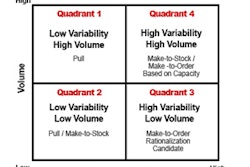Economists are predicting that the global economic crisis will continue through much of 2009. That was recently reinforced by the report from the Institute for Supply Management that its key manufacturing index had fallen at the end of 2008 to a level not seen in 28 years.
That is just the latest example of how today's economy is forcing many companies to take increasingly more drastic measures to positively impact the bottom line. The problem with that approach? So far, most of these drastic steps have been reactive, such as plant closures and layoffs. While that enables companies to achieve short-term gains of little significance, there have been very few long-term benefits so far.
That's why the procurement departments of leading Global 1000 companies are once again emphasizing the long-term impact of low-cost country (LCC) sourcing. With the present economic conditions not expected to get better any time soon, there are only so many plants they can close and so many workers they can lay off before they have to take a more strategic look at how they are sourcing their business needs.
So, sourcing managers face a dilemma: They must secure the same quality products for their manufacturing base at much lower prices. That's why suppliers in countries such as China and India, and those in Eastern Europe, are so critical today to the health of so many companies in developed nations. These LCC nations possess a huge supplier base that caters to a wide range of products and services for Global 1000 companies across all vertical markets.
With favorable currency conversion rates, these LCC locations have become huge offshore sourcing destinations. They offer high-quality product at much lower costs — including significantly lower labor costs — that have an impact on the total sourcing cost. And that may be the difference for businesses in developed nations looking to keep their doors open as the global economy continues to struggle in 2009.
The 30 Percent Rule
It is challenging in a global economy for sourcing managers to identify the best supply chain partners in many of these LCC locations. To do so, they must have reliable market intelligence data that are critical to ensure sourcing opportunities are in the company's best interest.
To achieve that, here are seven best practices I recommend for any Global 1000 company that is developing and implementing an LCC sourcing strategy:
Taking these steps are a good start, but the key to any viable LCC strategy is how much organizations can save in hard cash. As you get started with your LCC sourcing, an ideal metric to shoot for is to bring down your procurement costs by 30 percent or more.
The Automated Advantage
One of the biggest challenges global sourcing managers have when it comes to LCC sourcing initiatives is that many companies still rely on legacy manual approaches and suboptimal software solutions for sourcing.
It is little wonder then that chief procurement officers (CPOs) identify e-sourcing as the best method to enhance their sourcing savings compared to conventional approaches. An Aberdeen Group research report found that in the top 20 best-in-class companies it studied, 56.4 percent of spend is e-sourced. That resulted in an average of 10.4 percent in realized savings.
According to the report, enterprises have been able to achieve cost savings between 5 and 20 percent for each new dollar of spend brought under management. This presents more opportunities to identify savings from strategic sourcing efforts, reduce maverick spend, improve contract compliance and drive transactional efficiencies
As you can see, to ensure the success of the strategy it is essential to adopt automated tools in order to get the best results. Fully automated spend analysis tools also help by providing granular classification across languages and cultures that enable companies to negotiate better contracts. These spend analysis tools also support the strategic e-sourcing solution to help in identifying and short-listing 'best fit' suppliers in order to more efficiently facilitate the reverse auction process.
According to the Aberdeen Group report, best practices for any successful automated sourcing program should follow this process:
In addition to spend analysis and e-sourcing, contract management software augments strategic sourcing efforts to improve spend visibility for the organization by monitoring the negotiation, creation and execution of all contracts. Also, an effective supplier relationship management portal that bridges geographical and cultural differences should be used to maintain the vendor base. This also helps companies to achieve superior supplier discovery in all LCC locations throughout the sourcing process.
One final recommendation for companies considering an LCC sourcing strategy is to implement an automated supplier identification process in support of the e-sourcing, spend analysis and contract management tools mentioned above.
Surprisingly, for many companies this remains an arduous task wherein procurement personnel have to manually search for potential suppliers that can cater to specific commodity requirements. That is why it is so important to have automated market intelligence tools on hand that help enterprises create a supplier database with the detailed, granular information needed to quickly react to market forces in order to make sourcing decisions that will drastically reduce lead times.
Catching up Quickly
It is not surprising to anybody who knows the procurement business that corporate sourcing practices will have to change for the better because of the current economic conditions. But in order for that to happen, companies playing catch-up to the industry leaders will have to quickly adopt an LCC strategy on a large scale in order to attain higher efficiencies throughout the supply chain. And the way to do that is to implement the e-sourcing, spend analysis, contract management and market intelligent solutions other leading Global 1000 companies are already using today.
That is just the latest example of how today's economy is forcing many companies to take increasingly more drastic measures to positively impact the bottom line. The problem with that approach? So far, most of these drastic steps have been reactive, such as plant closures and layoffs. While that enables companies to achieve short-term gains of little significance, there have been very few long-term benefits so far.
That's why the procurement departments of leading Global 1000 companies are once again emphasizing the long-term impact of low-cost country (LCC) sourcing. With the present economic conditions not expected to get better any time soon, there are only so many plants they can close and so many workers they can lay off before they have to take a more strategic look at how they are sourcing their business needs.
So, sourcing managers face a dilemma: They must secure the same quality products for their manufacturing base at much lower prices. That's why suppliers in countries such as China and India, and those in Eastern Europe, are so critical today to the health of so many companies in developed nations. These LCC nations possess a huge supplier base that caters to a wide range of products and services for Global 1000 companies across all vertical markets.
With favorable currency conversion rates, these LCC locations have become huge offshore sourcing destinations. They offer high-quality product at much lower costs — including significantly lower labor costs — that have an impact on the total sourcing cost. And that may be the difference for businesses in developed nations looking to keep their doors open as the global economy continues to struggle in 2009.
The 30 Percent Rule
It is challenging in a global economy for sourcing managers to identify the best supply chain partners in many of these LCC locations. To do so, they must have reliable market intelligence data that are critical to ensure sourcing opportunities are in the company's best interest.
To achieve that, here are seven best practices I recommend for any Global 1000 company that is developing and implementing an LCC sourcing strategy:
- A reliable market intelligence system is needed to help identify the opportunities.
- Evaluate the cost-benefit ratio by taking into consideration the value of the item to be sourced, currency conversion rates, logistics support and other critical factors.
- Conduct a complete supplier validation exercise. This should include onsite visits, capabilities analysis and financial health assessments, just to start.
- Appoint a local resource to monitor supplier performance at all times. This person can also help implement your best practices to attain the desired quality levels and test the consignment prior to shipment.
- Diversify the sourcing basket by splitting sourcing partners among multiple locations. This risk management approach helps companies avoid or seriously mitigate the effect of adverse conditions in any one location, such as weather disasters, terrorist attacks or government unrest.
- Keep some critical sourcing in-shore as a safe bet against any untoward developments in LCC locations.
- Constantly evaluate your current suppliers as compared to other LCC prospects in order to make the most of future sourcing opportunities.
Taking these steps are a good start, but the key to any viable LCC strategy is how much organizations can save in hard cash. As you get started with your LCC sourcing, an ideal metric to shoot for is to bring down your procurement costs by 30 percent or more.
The Automated Advantage
One of the biggest challenges global sourcing managers have when it comes to LCC sourcing initiatives is that many companies still rely on legacy manual approaches and suboptimal software solutions for sourcing.
It is little wonder then that chief procurement officers (CPOs) identify e-sourcing as the best method to enhance their sourcing savings compared to conventional approaches. An Aberdeen Group research report found that in the top 20 best-in-class companies it studied, 56.4 percent of spend is e-sourced. That resulted in an average of 10.4 percent in realized savings.
According to the report, enterprises have been able to achieve cost savings between 5 and 20 percent for each new dollar of spend brought under management. This presents more opportunities to identify savings from strategic sourcing efforts, reduce maverick spend, improve contract compliance and drive transactional efficiencies
As you can see, to ensure the success of the strategy it is essential to adopt automated tools in order to get the best results. Fully automated spend analysis tools also help by providing granular classification across languages and cultures that enable companies to negotiate better contracts. These spend analysis tools also support the strategic e-sourcing solution to help in identifying and short-listing 'best fit' suppliers in order to more efficiently facilitate the reverse auction process.
According to the Aberdeen Group report, best practices for any successful automated sourcing program should follow this process:
- Analyze the opportunity
- Define the requirements
- Conduct supply market analysis
- Clearly define your sourcing strategy
- Conduct reverse auctions and RFPs (requests for proposal)
- Conduct supplier selection and award the contract
- Implement the contract
- Review and analysis
In addition to spend analysis and e-sourcing, contract management software augments strategic sourcing efforts to improve spend visibility for the organization by monitoring the negotiation, creation and execution of all contracts. Also, an effective supplier relationship management portal that bridges geographical and cultural differences should be used to maintain the vendor base. This also helps companies to achieve superior supplier discovery in all LCC locations throughout the sourcing process.
One final recommendation for companies considering an LCC sourcing strategy is to implement an automated supplier identification process in support of the e-sourcing, spend analysis and contract management tools mentioned above.
Surprisingly, for many companies this remains an arduous task wherein procurement personnel have to manually search for potential suppliers that can cater to specific commodity requirements. That is why it is so important to have automated market intelligence tools on hand that help enterprises create a supplier database with the detailed, granular information needed to quickly react to market forces in order to make sourcing decisions that will drastically reduce lead times.
Catching up Quickly
It is not surprising to anybody who knows the procurement business that corporate sourcing practices will have to change for the better because of the current economic conditions. But in order for that to happen, companies playing catch-up to the industry leaders will have to quickly adopt an LCC strategy on a large scale in order to attain higher efficiencies throughout the supply chain. And the way to do that is to implement the e-sourcing, spend analysis, contract management and market intelligent solutions other leading Global 1000 companies are already using today.


















